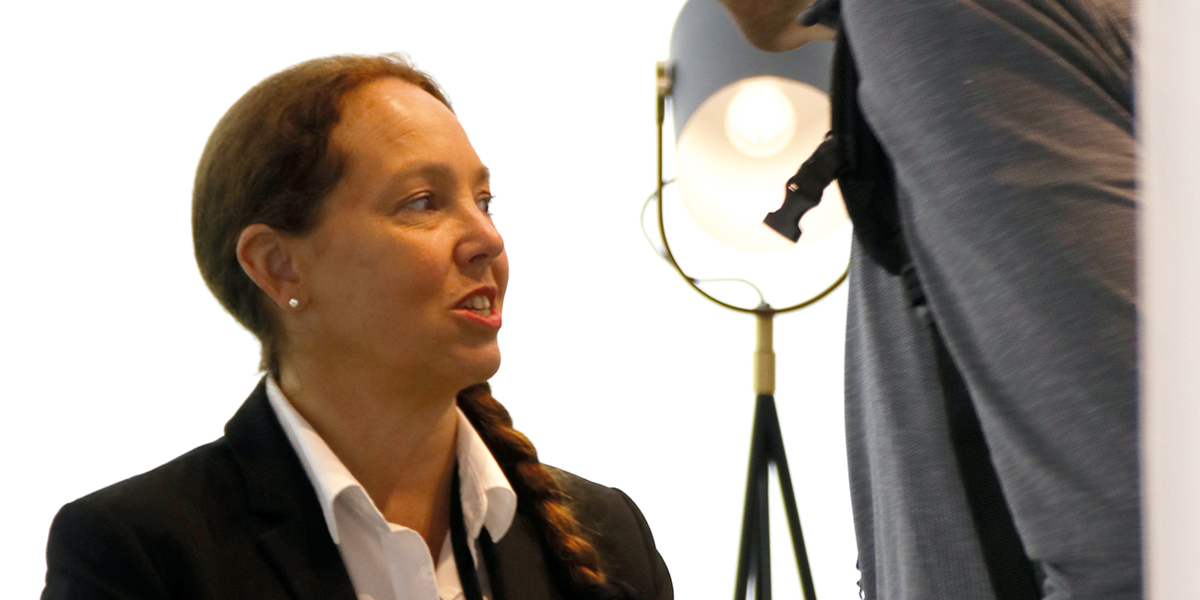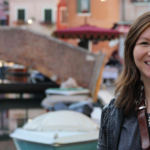Genius Interview: Regina Bernhaupt

Posted on Feb 10, 2023 by FEED Staff
Head of research for Ruwido and professor at Eindhoven University of Technology, Regina Bernhaupt, discusses the future of the TV experience – and the living room
FEED: In your time at Ruwido, how has the way home audiences interact with media evolved?
Regina Bernhaupt: I haven’t been working at Ruwido very long, at least by Ruwido standards. I’ve only been there about 15 years – the average at the company is more than 30! We’re a traditional, long-standing company, but have been trying to understand the future of interaction, especially when it comes to the living room. Looking back is always easy. Looking forward is more complicated.
To understand how media behaviour evolves, we at Ruwido use an expression – the ‘kernel’ of human behaviour – it’s something stable and doesn’t change much. This represents some basic needs and wants we experienced in the past. Our company is making products for controlling the living room. Everything has a form factor, so we might think of different remote controls or devices. But the deeper kernel is the idea that you want to control things remotely – and that doesn’t change. There’s a physical restraint people want to overcome, to interact with things that are far away. Then there’s a temporal aspect, wanting to enjoy something in the future or interact with another in the past, for example by recording content to watch later. Today, everything is instantaneous, but so much is going on at the same time that there’s a need to keep one in mind to watch later. We’re not very good at doing 25 things at once.
“Looking back is always easy. looking forward is more complicated”
FEED: What kind of research has been done on how audiences engage with content?
Regina Bernhaupt: We are investing a lot in trying to understand what values people have, and what long-term values people stick to when they make decisions. Decisions about installing things in the smart home, for example, or how they want to live, compared to how they want to work.
These long-term values are important to look at in terms of how people change, and they’re crucial when it comes to new trends and fashions. They change slowly over the years. Understanding them helps us look into the future and think about the media landscape and smart home in terms of design. So we are not just chasing fashionable gadgets, but looking for the things that have long-term impact.
FEED: How can these different value types be leveraged to create different outcomes?
Regina Bernhaupt: I’m working with a PhD student who is investigating a technology that has been around 20 years, but now has a new label – the ‘digital twin’. We can create a representation of user activity, with data from smart watches, fitness trackers or whatever other kinds of sensors are available, including smartphone data, then use that for classification or prediction.
Some of the providers we work with not only provide IPTV but also energy. They have access in the home to both data streams. So we can allow people in those areas to see how changing patterns of behaviour can work toward sustainability.
FEED: What are some of those user values you’ve discovered? And what insights have you gleaned about them?
Regina Bernhaupt: Psychologists have been doing a tremendous amount of work on that. We know a system that uses 12 values – and there can be even more. But that gets much too complicated, so we use four groups. There are the people who always want something new – the latest gadget – and change is important to them. Then people who want to become, in psychological terms, powerful – they want to have a career, to excel. On the other side, we have those who are very conservative and stick to what they’ve done for 20 years. Finally, there are empathetic people who want to support each other. This was a trait we saw gaining small percentages during Covid-19.
For sustainability, as an example, we know that the people who care about the latest gadgets don’t care as much about the environment, and people that really prioritise their career don’t worry as much about those issues either. But the people who care for other people, they also care for the environment. For the traditionalists, there is a split. They want to stick to the old traditional way, so are already behaving quite sustainably – they keep the old ways and use devices longer than other groups. We’ve seen people working on farms doing things the same way they did 100 years ago, because it’s better for the land. These people can be convinced of things, but typically are not the ones who like to spend.
FEED: Is gamifying a process a useful way to help people change behaviours?
Regina Bernhaupt: Gamification is different. In terms of behaviour change theories, we have about 60 approaches. But when you gamify, typically you only appeal to instant gratification. Long-term repetition is needed for behaviour change, so just a gamified approach is not a good one. A gameful approach with a deeply rooted intention to make something playful and keep people in the loop for the longer term can work, but not everyone will accept it.
If it’s too gameful, a traditionalist will say: “I don’t do these kinds of fancy things.” Others might say: “I’m not spending ten hours opting into something gameful. I already know it’s going to be hard to keep up.” I would be careful making an overall model of gamification for everyone you want to reach out to.
“When you gamify, typically you only appeal to instant gratification”

FEED: How do our past experiences change how we approach new technologies?
Regina Bernhaupt: In terms of interaction technique, people are very good at learning new skills. We have seen that with adoption of the smartphone and touch interaction. People are also reasonably good at voice interaction.
Something we are encountering more – and it’s part of sustainability – is what we call in my research group ‘old technologies’. If you want to keep a technology in the living room because it’s more sustainable, you need to come up with fancy technologies to piggyback on old ones to get the most out of it. I see a trend there: not to use more bandwidth, but to use it more wisely.
In the living room over the past 20 years, we have covered almost all the senses. You have knob turning, swiping, voice interaction – and we have seen continuously failed efforts to install camera technology. But people still want to just sit in front of the TV the way they always have done without requiring any special gestures. I don’t see lots of potential coming from a new modality.
One thing that could grow is extended reality, which will involve blending and allowing new digital additional information on old devices using projection. Instead of trying to point with a remote control, you have overlays that tell you what you are controlling. We will see more of a hybrid approach between the physical and digital. We could make data graspable.
FEED: What kind of success has voice control had? And how have people responded to security concerns?
Regina Bernhaupt: Like many waves of new technology, expectations on voice use were going up. But expectation is always higher than a technology can fulfil.
I speak Austrian German. But everybody here in Austria has a different dialect, and voice control just doesn’t work. If you’re speaking Upper German it works, but in the majority of cases the way we abbreviate things makes it difficult. We know that Swisscom is trying to address different dialects in Switzerland by using the person’s IP address, but that’s very expensive.
Adoption is different depending on the country. The US has the highest, whereas Europe is a bit more traditional. Asia has a variety of problems, including the diversity of languages and the need for better broadband. Some areas like South Korea have better adoption of voice features, but other areas don’t have the bandwidth or money for it.
Another issue is that voice is extremely convenient when it comes to browsing, but very inconvenient when it comes to user interface (UI) control. Having to say “Up, up, left, left…” doesn’t work. Or if you have a selection of movies from your search, it’s easy for people to say, “Select the first movie in the list.” Adoption of voice there also means the need to change the UI to make it work.
And we still have concerns about biometric data used in other applications. In one study, people were worried that because their crypto wallet was secured with a voice imprint, they could lose access to it. There’s no data about that happening, but these are some of the worries.
FEED: What will happen to the traditional TV remote? It has always been a symbol of power in the living room. Is the remote going to stay with us?
Regina Bernhaupt: Even if you take away the remote, the power is still with the person. In a social setting, someone always thinks they’re the one deciding. But it’s not about the physical representation. It’s allowing people to control something over distance. We see that becoming distributed, or supported by other devices.
It goes back to values: some want to be in control. But we need to support the idea that everyone is empowered to make choices, and so are looking into social control, too – not just in the living room, but in cars or other locations.
Social control is a means of enabling a group of people in a restricted environment to decide, for example, what Netflix movie do we watch. How exactly do you do that? Does the person with the remote decide? Do we have other types of device connecting, like a mobile phone? Do we allow voting?
People can store preferences. AI, depending on who is sitting in the living room, can make different recommendations. It’s about supporting this kind of access for multiple people. We are working on that at the moment; different types of social control have an enormous impact on the design.
FEED: Most of the world gets its video content through mobile? How do mobile viewers differ from those watching traditional TV?
Regina Bernhaupt: You get the feeling there’s a big split between the two. But those using a mobile device typically also enjoy watching something on a big screen. We know that when young people are away from their parents and have access to a big screen, this starts coming back into use.
Mobile usage is typically related to people’s life circumstances in the moment. If you look at that one moment, it feels like the groups have nothing in common, but over a generation you see some shifts in the uptake. Also, we know that TV adoption is becoming later because of the economic situation. It’s more expensive for children to move out and there is more sharing of living spaces.
FEED: You mentioned AI. What will AI and machine learning allow you to do with the viewing experience?
Regina Bernhaupt: We could do a lot, but I’m not sure if companies would be willing or able. With my professor hat on, I would say we can do almost anything. We’ve got data from how people interact with the remote in their hands, where we could possibly detect the onset of Alzheimer’s. It becomes possible to predict a lot with user data and behaviour, but society has to discuss the willingness and ethical consequences first.
We are looking at new ways of recommending content. The standard way of predicting what people want to watch may use five different parameters and some pre-programmed categories, but that doesn’t work anymore. We are trying to find out if these categories or features the algorithm is using actually make sense. Maybe there are different indicators in the data that we are not used to yet.
FEED: What will TV viewing be like ten years from now?
Regina Bernhaupt: I see old technologies staying. Recently, I had a product go to market that I had the idea for in 2007. This is a reasonably slow area in terms of turnover. The infrastructure cost is way too high for many things. And the current economic situation doesn’t allow huge investments over the next five years.
Something added or plugged into something you already have is more likely. We really have to understand how we can plug things in. The money is currently not out there – and we have to live with the old framework – then the innovation could easily come on top of that.
In some cases, it could be a smart projector, which is easy to install, displaying things on your current technology. But the future will not just be about higher resolution or full virtual reality where you need three additional glasses. People will simply not be willing to invest in that.
This Genius Interview first featured in the winter 2022 issue of FEED magazine.











